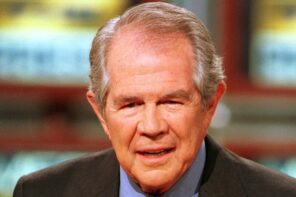E.J. Dionne’s bold pronouncement that “the era of the religious right is over” has been the subject of much discussion and debate. Those who agree cite the growing support for broadening the evangelical agenda to include issues like the environment (a.k.a. “creation care”), poverty, and HIV/AIDS. They also point to the graying of the religious right, most prominently the deaths of Jerry Falwell and James Kennedy, and the virtual collapse of the Christian Coalition.
Moreover, prominent old guard leaders like James Dobson and Pat Robertson have seriously damaged their credibility with many evangelicals by endorsing Mitt Romney, a Mormon, and Rudy Guiliani, a thrice-married, pro-choice New York governor, while passing over fellow-evangelical candidate Mike Huckabee. No one need ask for a more bald demonstration of prioritizing power over principle from the self-proclaimed leaders of “values voters.” Skeptics of the decline of the religious right, on the other hand, cite the huge infrastructure, resources, and reach the religious right has built over the last few decades (to take just one example, James Dobson’s sprawling conglomerate has its own zip code in Colorado Springs and a larger monthly print circulation than the New York Times) and argue that it will not so easily wither on the vine. The most jaded on the left simply assert that the religious right is the truest expression of the heart of the evangelical community and is thus here to stay.
If the argument that “the era of the religious right is over” depended solely on what one might call the “graying and greening” argument—that the leadership is aging and out of touch and that a few issues like the environment have simply been attached to a persistent static core—I, too, would be skeptical. I want to argue, however, that the reason I believe Dionne is right is that a more thoroughgoing and measurable shift is happening within the evangelical community, one that represents not simply a broader agenda but also a significantly different spirit and worldview.
Last week, Dr. David Gushee, Distinguished University Professor of Christian Ethics at Mercer University and author of The Future of Faith in American Politics: The Public Witness of the Evangelical Center, talked compellingly about the arrival of the evangelical center at a standing-room-only presentation at Third Way, a progressive think tank in Washington, DC (full disclosure: I am currently a Visiting Fellow in Religion at Third Way.) He was joined by a panel of leaders representing this emerging center: Dr. Ron Sider, founder of Evangelicals for Social Action and the Evangelical Environmental Network; Rich Cizik of the National Association of Evangelicals and leader of the Creation Care movement; and Sam Rodriguez, founder of the National Hispanic Christian Leadership Conference. Gushee described the political implications of the emerging evangelical center as follows (edited for space):
While Gushee has convincingly described the players and posture of the emerging evangelical center, quantifying these differences is challenging. In work I co-authored with Rachel Laser of Third Way last fall, we found a persistent pattern we dubbed the one-fifth, one-third, one-half formula: on a broad range of social issues, one-fifth of evangelicals are progressive, one-third are moderate, and one-half are conservative. We also found that the moderate third was increasingly distancing itself from the right. Our findings were consistent with Frances Fitzgerald’s conclusions last year in her New York Review of Books article, “The Evangelical Surprise” Fitzgerald concluded that “half of the evangelical population doesn’t see eye to eye with the other half”—this is true both in terms of substance and tone.
Another good place to look for quantifiable evidence of the increasing isolation of the evangelical right is the 2006 Religion and Public Life Survey from Pew, which contained a “social conservatism index,” which can serve as a proxy for these left-center-right divisions.
The Pew social conservatism index reveals some deep chasms between the evangelical left/center and right. On social issues, the differences are most pronounced on the issues of stem cell research, abortion, and the morning after pill. A majority of left/center evangelicals support stem-cell research, legalized abortion, and access to the morning after pill without a prescription. There is a remarkable 50-point gap between left/center and right evangelicals on each of these issues. Importantly, more than 8 in 10 in the evangelical left/center want to find middle ground on abortion laws, while 6 in 10 in the evangelical right think there’s no room for compromise on abortion.
On gay and lesbian issues, while only a quarter of the left/center evangelicals support allowing gays and lesbians to legally marry, a near majority (49 percent) support allowing gay and lesbian couples to enter into legal agreements with each other that would give them many of the same rights as married couples, compared to only 11 percent of the evangelical right.
Finally, this analysis reveals that these different views of left/center evangelicals are rooted in different religious sensibilities than the evangelical right. For example, while nearly all evangelicals affirm that the Bible is the word of God, less than half of left/center evangelicals are biblical literalists (i.e. believing that the Bible is to be taken literally word for word), compared to nearly three-quarters of the evangelical right. Most significantly for public policy, a majority of left/center evangelicals say the will of the people should be the more important influence on US laws, even when it conflicts with the Bible; while a remarkable 82 percent of the evangelical right hold that the Bible should trump the will of the people in making laws.
These numbers support Gushee’s qualitative conclusions that there is indeed a new evangelical center emerging. This movement goes beyond a simple graying and greening of the movement and is rooted in a different cultural posture and style. This new movement is no less evangelical than the right. But it promises to be less strident, less partisan, and less defensive; it also promises to be more creative and more willing to follow conclusions into unconventional places to work for the common good. In fact, one might argue that these traits make it more authentically evangelical than the right has been. This election year should provide an unprecedented lens on the emerging evangelical center. But even if this nascent movement doesn’t translate directly into large voting shifts, the evangelical left/center (half of evangelicals and 13 percent of voters) has the real potential to partner with political progressives on a range of issues going forward in ways that defy the conventional wisdom of “the era of the religious right.”





